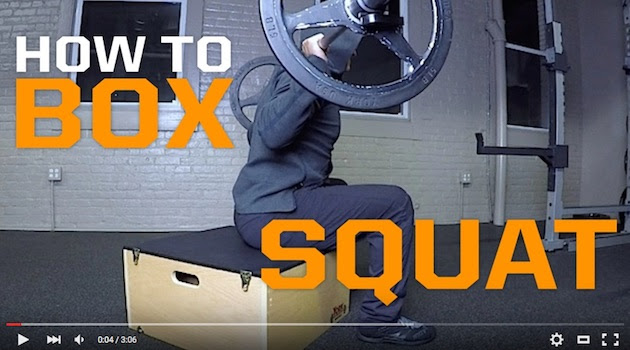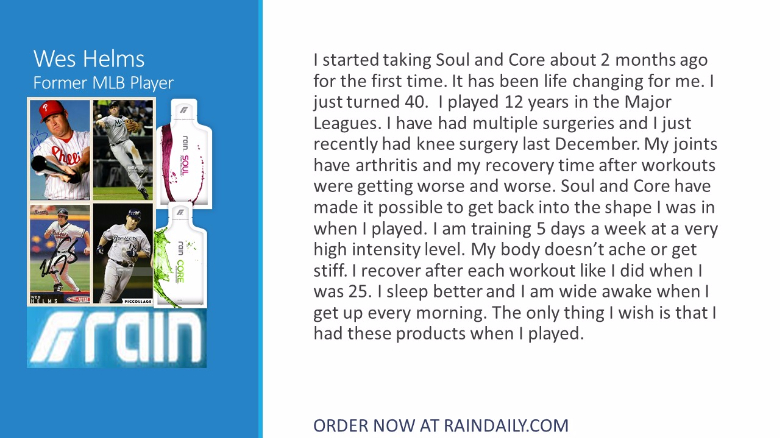Good Morning Athletes and Warriors!
First off hats off and salutations to all of you who have signed up and are working your programs hard this winter. Believe and receive that your hard, dedicated work will pay dividends beyond your imagination because you have decided to make your fitness as lifestyle for a life time! As it takes a village to get all of the right strength, conditioning, and overall fitness information into you hands here is Coach Joe with another great video demo of a tried and true lower body exercise. Enjoy! -Nate I filmed this learn-by-doing video for you. It's called "How to Box Squat" and I think you'll like it. In short, the box squat is superior to the traditional squat because it "turns off" the elastic effect most folks experience when you bounce at the bottom of a classic squat. Because you actually stop your motion at the bottom of the box squat, you build more starting strength. This move is also excellent if you have nagging knee pain and think you can't ever squat again. Why does it help with pain? Mainly because you can position your feet so you maintain a vertical shin angle. I explain more here...  VIDEO == How to Box Squat Take three minutes to watch the video and then reply to this email with any feedback or questions. I'll do my best to get back to each and every one who emails. Train hard and stay safe, Coach Joe P.S. If you know someone with a bad back or knee pain, this video can help them out. Please forward.
Reach 6 Million New Customers Every Week With US Sports Marketing. Home Of The All-Biz Advertising Specials. Effective, Affordable Sports Marketing With Your Positive Bottom Line The Top Priority
Let's Boost Your Business Today! http://bit.ly/USSportsMarketing
US Sports Online Strength and Conditioning Powered By RAIN's SOUL!
 |
Showing posts with label dead lift. Show all posts
Showing posts with label dead lift. Show all posts
Thursday, December 29, 2016
How To Box Squat
Friday, August 12, 2016
The King of All Exercises!
 Good morning Athletes and Warriors! Good morning Athletes and Warriors!If you have ever trained with me in person or online you know at one point or another I have conveyed to you that the Barbell Squat and all of its cousins (lunges, dead lifts, etc.,) Are the most important exercises in your program. Why? Here's coach Joe and friends to give you the 'low down' (you'll get that pun from reading on in the article) On the Emperor of exercises. -Nate Squats have been called the "king of all exercises" for good reason. Because they train a mass amount of tissue in a very time efficient manner. But squats also have a bad rep for damaging your knees. In this guest article by Coach Rippetoe, you'll learn the truth about squats. How to Do a Perfect Squat by Mark Rippetoe "Squats are bad for the knees" is the biggest myth in weight training. You may have heard that full squats are bad for your back, too. The correctly performed squat is a hips-dependent exercise. It doesn’t really stress the knees much at all. And the correct position at the bottom of the squat does in fact load the back. Which is fine, because the squat is a back exercise too. What's the correct bottom position of a squat? The hips are just below the level of the top of the knees, the shins are not quite vertical, and the feet and the thighs are aligned so that there is no twisting in the knees and ankles. The back is at an angle that supports the load, and the hips are positioned to do most of the moving of the load. In this position, the knees are barely involved. Both the knees and the hips have to bend in order to lower and raise the bar, but in the correctly performed squat the majority of the load is on the hips and back. If this position is unsafe, toilets are in trouble. When the hips are shoved back into a position that takes the load from the knees, another very important thing happens: The hamstrings are tightened.The hamstrings connect the back of the tibia to the hip, and therefore exert a backward tug on the knee. This quite effectively counters the forward pull on the knee from the quadriceps. But this protective effect takes place only if the hamstrings are tightened by sliding the hips back into the full squat position — it doesn’t occur if the knees stop above parallel, at 90 degrees. If the back stays too vertical, the hips aren’t loaded, the knees are. The hip joint is a robust stable structure that is capable of handling heavy loads without injury. The muscles around the hips are the biggest muscles in the body, and they have the greatest potential to get stronger — if we load them correctly by making them work against the leverage generated with proper technique. To load the hips, we must have a more horizontal back angle. In the squat, the back functions as a solid segment, a force transmitter between the hips and legs and the barbell on the back. It is held as a rigid stable segment by all the muscles of the trunk — the spinal erectors, the abdominal muscles, and all the muscle mass that surrounds and supports the spine. Therefore, the squat is a back exercise too, and as the back muscles do their job of keeping the back rigid as the weight gradually increases over time, the squat gradually strengthens the back just as it gradually strengthens the hips and legs. ## If you are feeling up to it, try my "100-Rep Squat Workout" here. I've included a how-to video and some helpful tips. Train hard and stay safe, Coach Joe P.S. If you do attempt the squat workout, start with no more than 95 pounds! Joseph Arangio Tactical Workouts for Military and Law Enforcement Claim Your Gift: 5 Tactical Training Videos ==
|
Thursday, October 30, 2014
Lifting weights is as important to physical fitness as aerobic exercise.
The big 'duh' but just in case you didn't know, cardio by itself only will not cut it. -Nate
Although aerobic exercise burns far more fat calories, weight lifting or resistance training, increases your lean body mass. Muscle tissue is metabolically active. It uses as much as 45 calories per pound per day to sustain itself. The more muscle tissue you have, the higher your resting metabolism. Even when watching television, the local gym rat burns more calories than their couch potato neighbor. So, while aerobic exercise burns fat during and briefly after a workout, the lean muscle tissue that is gained by lifting weights burns calories around the clock. That's especially important if you want to decrease body fat.
Stronger muscles also enable you to perform daily activities more easily. The result is less fatigue at the end of the day. Well conditioned muscles also reduce your risk to injury.
Strength training is a highly individualized procedure. That's why two equally successful strength athletes may have very different training routines. Nevertheless, in order to increase muscle mass or lean tissue, you need to train with weights a minimum of two to three times per week. US Sports Strength and Conditioning offers customized fitness programs that are tailored to your individual fitness goals.
The American College of Sports Medicine now considers resistance training a necessary component of any sound exercise program. So regardless of what your fitness goal may be, get out there and toss some weight around.
|
" He (Nathan) consistently asked for feedback on how I was feeling and if I had any pain, soreness or problems...Nathan your passion and commitment to your work is truly inspiring." Michelle Trainee for 5 months.=======================
|
Thursday, September 11, 2014
To belt or not to belt? Always a question
Yes, there are many who abuse weightlifting belts. There are times as well when it is a smart move. Here is a guide:
The necessity for a weight lifting belt is dependent on the kind of resistance training you're doing and how much weight you are lifting. Weight lifting belts help support the torso during heavy lifting--especially in squats and deadlifts. As a general rule, if you are performing a lift that requires significant torso stabilization and using more than 75 percent of the total weight you can lift just once, you may need the extra support a belt offers.
The downside of depending on a weightlifting belt continually for support, is that this can result in a weakening of the abdominal and lower back muscles that are so important to body stability. If you're going to use a weight lifting belt don't neglect strengthening your abdominals and back extensors.
A weightlifting belt should be about four inches wide and fit snugly around your abdominals and lumbar region.
Subscribe to:
Comments (Atom)







